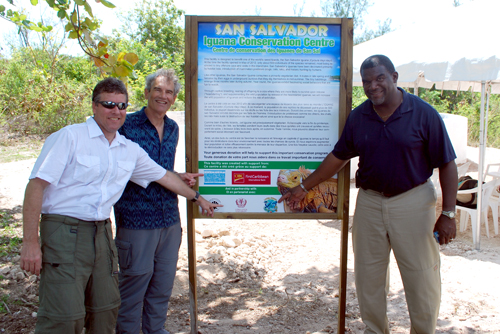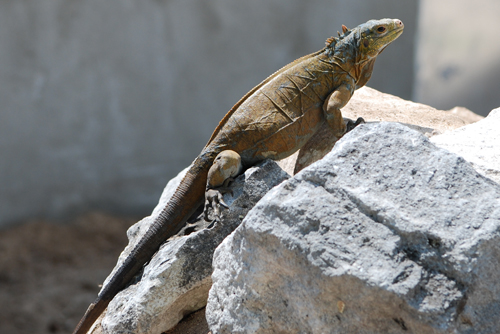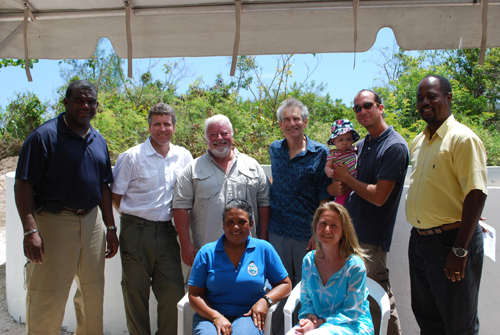|

|
 |
|
Last Updated: Feb 6, 2017 - 2:32:04 PM |

A wonderful aspect of the project is the partnership created between science and local conservation. Here William K. Hayes, Professor of Biology at Loma Linda University, Michael Goffee, President of San Salvador Living Jewels and Duane Silverstein, Executive Director of Seacology are the with Centre's sign. As the new center will raise awareness and support for conservation on the island, San Salvador Living Jewels is working with the Bahamas National to submit a proposal for a new National Park focusing protecting iguana and sea bird nesting habitat as well as an extensive tidal creek area.
|
THE BAHAMAS - An important step forward has been taken in the protection of the endangered San Salvador iguana. The new San Salvador Iguana Conservation Centre, located at the Gerace Research Centre on San Salvador Island in the southern Bahamas, was opened on May 9th. The Centre will breed and raise the local iguanas until they are large enough to be safely released in selected areas around the island. At present, only about 500 of these iguanas cling to a precarious existence on tiny offshore cays and small islets in the inland lake.
In attendance at the opening were representatives from the Island’s Administrator, local conservation organization San Salvador Living Jewels, the Bahamas National Trust, William K. Hayes, Ph.D, of Loma Linda University who partnered with San Salvador Living Jewels and Tom Rothfus of the Gerace Research Center to get the project funded, and project sponsor Seacology. A representative from the other project sponsor, FIBC FirstCaribbean Bank, was unable to attend but sent remarks.

The new facility was created to protect the endangered Sal Salvador Iguana. Four females and two lucky males are currently residing in the exhibition and breeding pen. The main goal of the program is to raise juvenile iguanas to a size large enough where they can fare well upon release to the wild, thereby supplementing the natural population which is around 500 right now.
|
Seacology, a nonprofit organization based in California, decided to fund the project as it fell in line with their mission of saving endangered species, habitats and cultures of islands throughout the world. Already their efforts have resulted in more than 1.6 million acres of critical habitat being preserved around the world. This is their first project in The Bahamas, but a second in Abaco is already underway. Executive Director Duane Silverstein, who attended the opening says, “It has been said that the sin for which future generations will least forgive us is extinction of species. Seacology is proud to do its part to keep the San Salvador iguana from vanishing from the face of the earth."
Their partner in the funding, FIBC FirstCaribbean, saw their support of this project as “further tangible evidence of its commitment to its communities, a promise made back in 2002 when the Bank was formed,” says Marketing Manager Andrea Myers-Tanguay. The Bank also donates to Junkanoo Groups in The Bahamas and was a major sponsor of the recent Carifta Swimming Championships held in Nassau.
The main iguana exhibition and breeding pen is now complete and ready for visitors, along with an information kiosk. Four females and two lucky males are currently residing in the exhibition and breeding pen. Professor of Biology Dr. William Hayes was, “absolutely amazed at how well adjusted the animals are. They nonchalantly explore their new home, watch us humans with curiosity, and eagerly consume the food provided.” He explains how those animals were chosen for the project, “We selected animals from a single location on Green Cay so that they would be familiar with each other and adjust well socially. They should thrive in their new home as ambassadors for their kind. The females have ovulated, and if not pregnant already, they soon should become so. The main goal of the program is to raise juvenile iguanas to a size large enough where they can fare well upon release to the wild, thereby supplementing the natural population. We foresee this population increasing substantially in the years to come as the result of this new facility, thereby ensuring their survival for future generations of humans to enjoy.”

In attendance at the opening were representatives from the Island’s Administrator, local conservation organization San Salvador Living Jewels, the Bahamas National Trust, Loma Linda University, the Gerace Research Centre to get the project funded, and project sponsor Seacology. A representative from the other project sponsor, FIBC FirstCaribbean Bank, was unable to attend but sent remarks.
|
Of further interest to funders CIBC FirstCaribbean and Seacology was the partnership the project created between science and local conservation. San Salvador Living Jewels is working with the Bahamas National to submit a proposal for a new National Park focusing protecting iguana and sea bird nesting habitat as well as an extensive tidal creek area, which acts as a nursery for a number of important species. Lindsey McCoy, Bahamas field representative for Seacology says, “It is the hope of all of us working together on this project that it will lead to the declaration of a much needed new national park on and around San Salvador."

© Copyright 2012 by thebahamasweekly.com
Top of Page
|
|
 |

|
